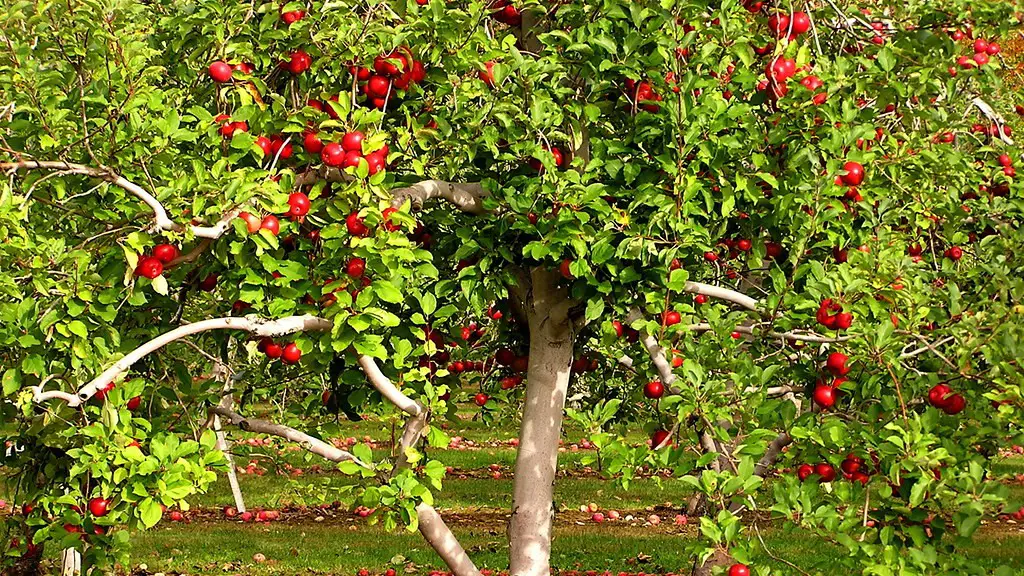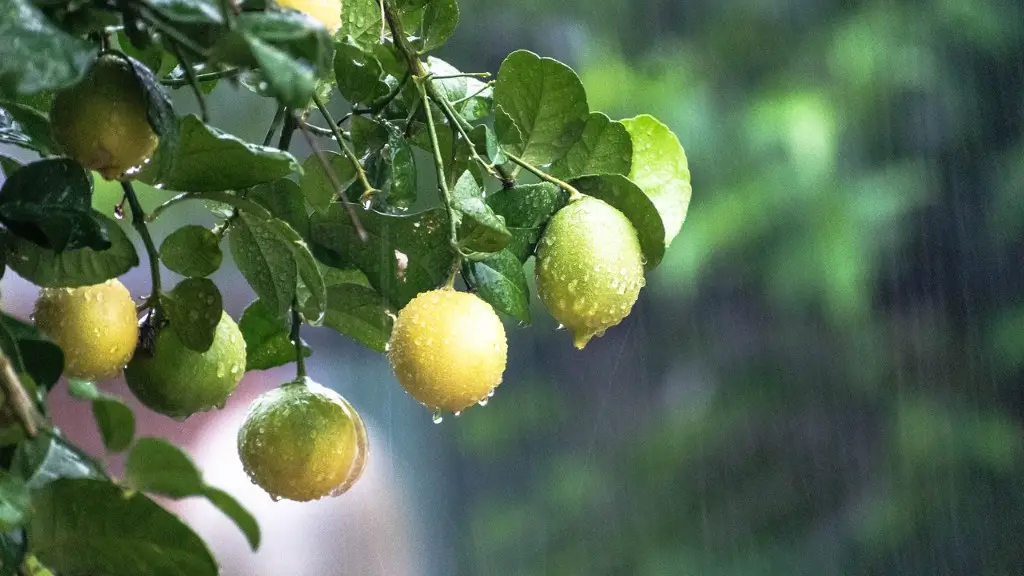Apple trees are renowned for their relatively fast growth rate. While there is a great deal of variability in terms of how quickly a particular tree may grow, on average, they generally take between six and eight years in order to reach full growth. During this time, the tree will produce apples, provided certain conditions such as appropriate sunlight, water, and fertilization are met.
Apple trees grow faster in warmer climates due to the longer growing season. In areas where the growing season is particularly short, such trees may take longer to reach full maturity. Additionally, ample amounts of water, sunlight, and fertilization are essential components of optimal apple tree growth.
The root system of the tree is also an essential consideration in terms of growth rate. The tree’s roots must be able to access nutrients and hold on to them in order for optimal growth to be achieved. This can be accomplished by planting in an appropriate soil, or through a process known as “root pruning” in which the tips of the tree’s roots are cut in order to encourage new growth.
Apple tree growth isn’t limited to just its height. Its branches and trunk must also expand in order for the tree to reach its full potential. This process is often sped up through a process called “training”, as it encourages growth in these key areas. Additionally, young apple trees need to be regularly pruned. This helps to create a good framework of branches so that the tree will bear plenty of fruit.
Finally, the overall health of the tree is important to its growth rate. Trees in poor health are far more likely to develop diseases, which can severely stunt their growth. Moreover, if the tree is infested with pests, it can be difficult for it to grow optimally. Some pests, such as codling moth, can actually lay their eggs in apple tree blossoms, causing delays in the tree’s growth.
Issues Associated with Too Rapid Growth
Rapid growth in apple trees can lead to a number of problems. The main issue is that the tree can become top-heavy, which can cause it to be more susceptible to wind and snow damage. Additionally, rapid growth can sometimes stunt the tree’s growth in other areas, such as in its root system and in fruit production. This can sometimes necessitate corrective measures such as root pruning or heavy pruning of the tree’s branches, in order to bring it back into balance.
Furthermore, it is often the case that apple trees that grow too quickly are more likely to suffer from various types of diseases and pest infestations. This is due to the fact that the quick-growing tree will be consuming more nutrients, leading to weakened tissue and a decreased resistance to disease. In addition, such trees can require more maintenance, as their branches may need to be firmly supported in order for the tree to remain upright.
Ultimately, although a fast-growing apple tree is desirable, it must be kept in balance in order to remain both healthy and productive.
Soil Composition and Nutrients
Soil composition and the presence of adequate amounts of nutrients are also essential factors when it comes to achieving a healthy and productive apple tree. Usually, fertile soil with ample amounts of organic matter and nitrogen is ideal. Additionally, the soil pH should be between 5.5 and 7.0 in order for the tree’s roots to be able to access necessary nutrients. If the soil’s pH is too high or too low, serious apple tree growth issues can arise.
The use of fertilizers can be beneficial in terms of rapidly increasing the tree’s growth rate. However, it is important to ensure that the appropriate type of fertilizer is used, as well as that it is used in the recommended doses.
Otherwise, over-fertilization can lead to a buildup of salts in the soil and create other issues. Furthermore, if the tree receives too much fertilizer, its growth rate can actually be stunted.
Finally, it is important to ensure that the tree is receiving adequate amounts of water. Generally, it is recommended that the tree be watered at least three times per week, either through manual irrigation or through irrigation systems. This helps to ensure that the tree is getting sufficient amounts of water without becoming overly saturated.
Light Conditions and Apple Tree Growth
In addition to soil composition and water, adequate amounts of sunlight are essential for optimum apple tree growth. Usually, apple trees prefer sunny, bright areas, as this helps to facilitate photosynthesis, the process by which a tree absorbs and uses light to produce energy. Usually, south-facing slopes in areas with plenty of sunlight are preferable.
Furthermore, shade can be detrimental to a tree’s growth. Too much shade can hinder photosynthesis and prevent the tree from receiving essential nutrients and energy. That being said, it may be necessary to prune branches and reposition any large-growing trees nearby in order to ensure that the apple tree is receiving enough light.
Additionally, artificial light sources such as LED grow lights can be beneficial in terms of providing the tree with additional light energy. This is particularly beneficial during the winter months or in shaded areas, as it helps to ensure that the tree is receiving sufficient amount of light even when natural sources of light are lacking.
Pruning and Apple Tree Growth
Pruning is often necessary in order to ensure the optimal growth rate of an apple tree. Pruning helps to ensure that the tree’s root system is healthy and properly balanced. It also helps to provide the tree with additional light by cutting away branches that are blocking the sun. In addition, pruning also encourages fruit production by allowing the tree to direct more of its energy towards producing fruit rather than growing more branches. Finally, pruning also helps to make the tree less vulnerable to wind and snow damage.
Ideally, apple trees should be pruned in the late winter months or early springtime, once the trees have slowed their growth for the year. Pruning should be carried out with sharp bypass pruners, or with a pruning saw for larger branches. It is also important to remove any dead or diseased branches promptly in order to ensure the health of the tree.
Fertilizers and Apple Tree Growth
Fertilizers can play an important role in facilitating apple tree growth. In general, nitrogen-rich fertilizers are the best choice, as they help to ensure adequate growth in the tree’s branches and leaves. Additionally, phosphorous-rich fertilizers are beneficial in terms of promoting the development of the tree’s root system.
It is important to note that over-fertilizing can be just as detrimental to a tree’s growth as under-fertilizing. Too much fertilizer can cause a build-up of salts in the tree’s soil which can make it difficult for the roots to access essential nutrients. For this reason, it is important to make use of good-quality, slow-release fertilizers.
Furthermore, it is important to ensure that the fertilizer is evenly distributed throughout the root zone. This can be accomplished through a process known as “broadcasting”. For optimal results, the fertilizer should be applied after the tree has finished blooming in the spring and again in the fall.
Wind Damage and Apple Tree Growth
Wind can be a major issue in terms of apple tree growth. High winds can cause extensive damage to a tree, resulting in broken branches or even uprooting. To prevent this, it is important to have adequate wind protection available for the tree. For example, if windbreaks or wind-blocking structures such as fences or trellises are available, these can help to protect the tree from wind-related damage.
Furthermore, it is important to ensure that the tree is planted in an appropriate location. For example, if the tree is planted in an open area that is vulnerable to strong winds, it is more likely to be damaged than if it is planted in a sheltered area with windbreaks. Additionally, the soil should be deep and loose, as this helps to provide a better anchor for the tree’s roots and make it less vulnerable to wind damage.
Finally, it is important to ensure that the tree has an appropriate structure. For example, if the tree lacks an appropriate framework of branches, it may be more susceptible to the wind. Thus, it is important to regularly prune the tree and train it to create an even, balanced structure.



